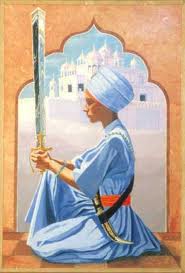In 1499, hundreds of years before the full equality of women was established anywhere else, Guru Nanak said:
“From woman, man is born;
within woman, man is conceived; to woman he is engaged and married.
Woman becomes his friend; through woman, the future generations come.
When his woman dies, he seeks another woman; to woman he is bound.
So why call her bad? From her, kings are born.
From woman, woman is born; without woman, there would be no one at all.”
To understand why such a concept as “women’s equality” was such a big deal, we need a little context.
Guru Nanak lived in northern India among Hindu religious/cultural values and Islamic rule by the Moguls. Because the Hindu way is quite open with spirituality, various texts speak both lowly and highly of the woman’s position in society. Despite these differences, for the Sikh Guru’s, a few common practices among Hindu’s really got under their skin.
-
Sati: the act of a living wife burning herself alive on the funeral pyre of her husband. As with many cultural traditions, it stems from a story regarding Hindu gods and goddesses.
Guru Nanak, as well as other Guru’s, abhorred this practice, as seen in this passage of the Guru Granth Sahib:
“By burning oneself, the Beloved Lord is not obtained.
Only by the actions of destiny does she rise up and burn herself, as a ‘satee’.
Imitating what she sees, with her stubborn mind-set, she goes into the fire.
She does not obtain the Company of her Beloved Lord, and she wanders through countless incarnations.”
Other common practices the Guru’s spoke out against and reforms made at the time included:
-
Equal education for men and women
-
Female infanticide (to be fair, Muhammad spoke against this as well)
-
Avocation of widow remarriage
-
No distinction between men and women of the Khalsa order. All wear the 5 K’s. All called to defend the oppressed.
While Islam had taken strides in its early years to increase the standing of women in society, old traditions of subjugating women and considering them second class or weaker citizens remained. This ideal was propogated by twisting Quranic verses which point out the greater power/ability of men (Quran 4:34), and unequal inheritance rights. By molesting the intention of these verses, women were viewed more as property than partners in the home.
From Guru Amar Das, in the Guru Granth Sahib:
“They are not said to be husband and wife, who merely sit together. Rather they alone are called husband and wife, who have one soul in two bodies.”
In many religions at the time (and in most social settings), it was not only improper for a women to sit in congregation on the same level as men, but unheard of for women to lead in any capacity in society–especially religious services.
The Guru’s fixed both of those problems.
“Come my sisters and dear comrades! Clasp me in thine embrace. Meeting together, let us tell the tales of our Omnipotent Spouse (God). In the True Lord are all merits, in us all demerits.” –Guru Nanak
Sikh women sit on the same floor, on the same level as men (not behind them or in segregated, “lower” sections), during services. Sikh women also often lead in congregational readings of the Guru Granth Sahib, lead prayers, carry out ceremonies, serve as Granthi (custodians in the gurdwara), and even fight along side their Khalsa brothers in combat. Sikh women are considered “the conscience of men” and enjoy every right men do as their partners in life.
One of my favorite stories about the valor and tenacity of Sikh women is that of the Battle of Anandpur. Click the link to read the story. Basically, about 100 GurSikh women, after having served in the fort as nurses to the Sikh men, took up arms after all but 10 of the Sikh warrior men had died defending the fort. The Sikh women, having taken the Guru’s Amrit and being Khalsa themselves, told the men who worried that the enemy would rape and dishonor them, “Brothers, do not worry about us. The enemy cannot enter the fort while we are alive.”
I’ll let you find out what happened. It’s worth the read.
Freedom also comes with responsibility, but from what I’ve read and seen, Sikh women have no problem with this task. Whenever I look at my own daughters, how independent they are and how passionate they express themselves, I think about these brave Sikh women. The Guru’s recognized that society cannot move forward without all of its components moving as one and with one purpose. Indeed, how can we come to a spiritual awakening as a species when we still wrestle with social pains? The Sikh answer of full equality for all mankind offers a worthy solution.


